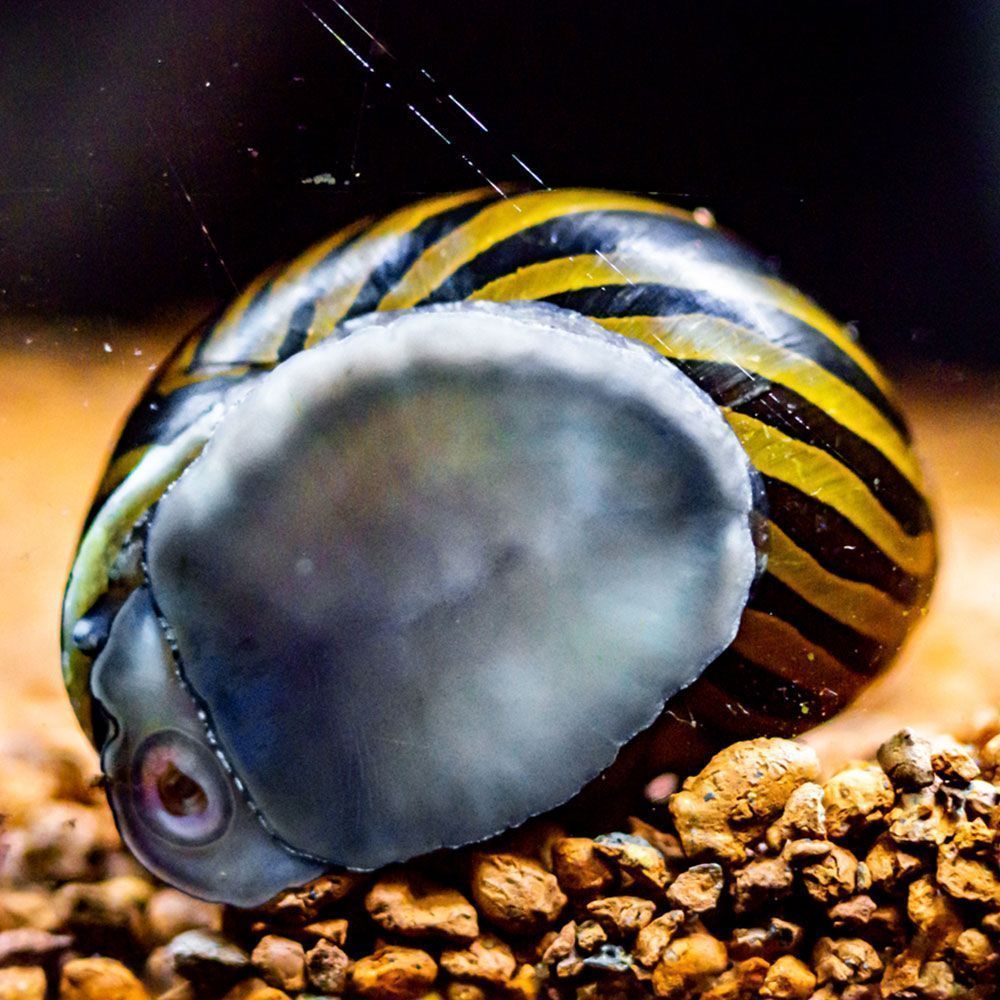Nerite snails are a great choice if you want a calm and low-maintenance little invertebrate for your freshwater aquarium.
They are excellent tank cleaners known for their impressive algae-eating skills. An imminent part of the aquarium cleaning crew, they share this role with Amano shrimp.
As long as they have a peaceful setting and the right water conditions, these small snails can be wonderful additions to your tank.
What are Nerite Snails?
Nerite snails are creatures that belong to the Neritidae family and are well know for their tank cleaning skills among aquarists.
| Origin | East Africa, Kenya, Mozambique, Somalia, South Africa and Tanzania |
| Order | Cycloneritida |
| Family | Neritidae |
| Scientific Name | Vittina natalensis |
| Common Names | Spotted nerite, nerite snails |
| IUCN Red List Status | Near Threatened |
| Appearance | Dark brown to black spiral-shaped shells, tentacles on the head with eyes, operculum on shell, muscular foot with radula |
| Size (Adult) | 2.5 cm (1 in) |
| Lifespan | Up to 5 years |
| Temperament | Peaceful |
| Tank Level | All levels |
| Water Temperature | 72-78 °F (22-25 °C) |
| pH Level | 7-8.4 |
| Water Hardness | Freshwater: 6.0 to 12.0 dGH |
| Care Level | Easy |
| Minimum Tank Size | 10-20 gallons |
| Tank Environment | Tank with live plants and hiding places |
| Diet | Herbivorous |
| Tank Mates | Peaceful tankmates |
Which family does Nerite Snails belong?
Under the order Cycloneritida, in the family Neritidae, all snails are called “nerites.” Some of these thrive in freshwater, some in saltwater, and others in a mixture of environments.
Currently, the family consists of over 200 species, and the most notable of them all are spotted nerite snails, scientifically known as Vittina natalensis. They are assessed on The IUCN Red List as Near Threatened.
Fun Fact: The specific epithet “natalensis” in the scientific name of nerite snails refers to the Natal region of South Africa.
What are the Types of Nerite Snails?
While the article will mainly focus on spotted nerite snails, let’s know about a few more popular nerites here.
1. Horned Nerite Snail (Clithon corona)
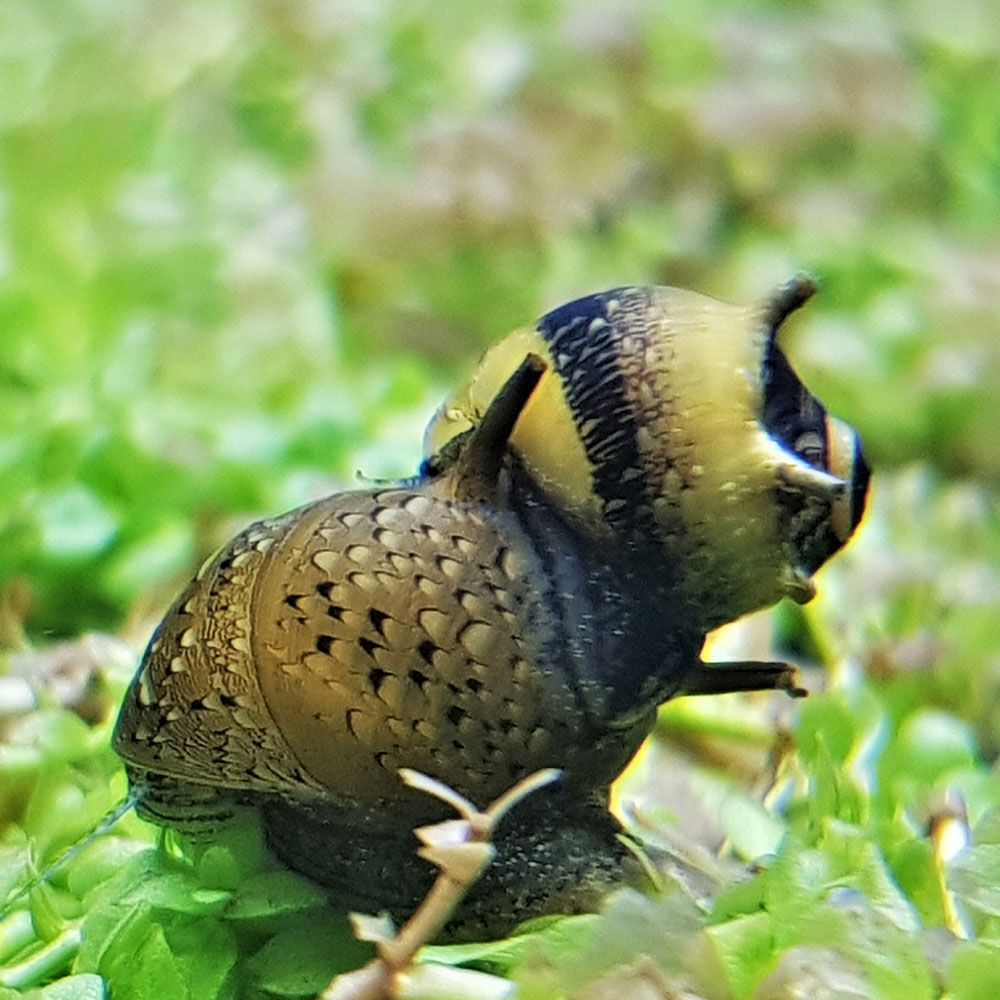
- Common Names: Zebra horned nerite snail, sunny snail, bumblebee snail
- Average Size: 1.3 to 2 cm (0.5-0.8 in)
- Average Lifespan: Around a year
- pH Levels: 7-8
- Water Temperature: 72-79 °F (22-26 °C)
- Minimum Tank Size: 10 gallons
Usually, the smallest of the nerites, horned nerite snails, originate from brackish and freshwater regions of Africa. They can’t breed in freshwater.
The omnivores have multiple dark thorn-like projections that serve as a defense mechanism. Their shell is golden with bold black and yellow swirls.
2. Zebra Nerite Snail (Vitta zebra)
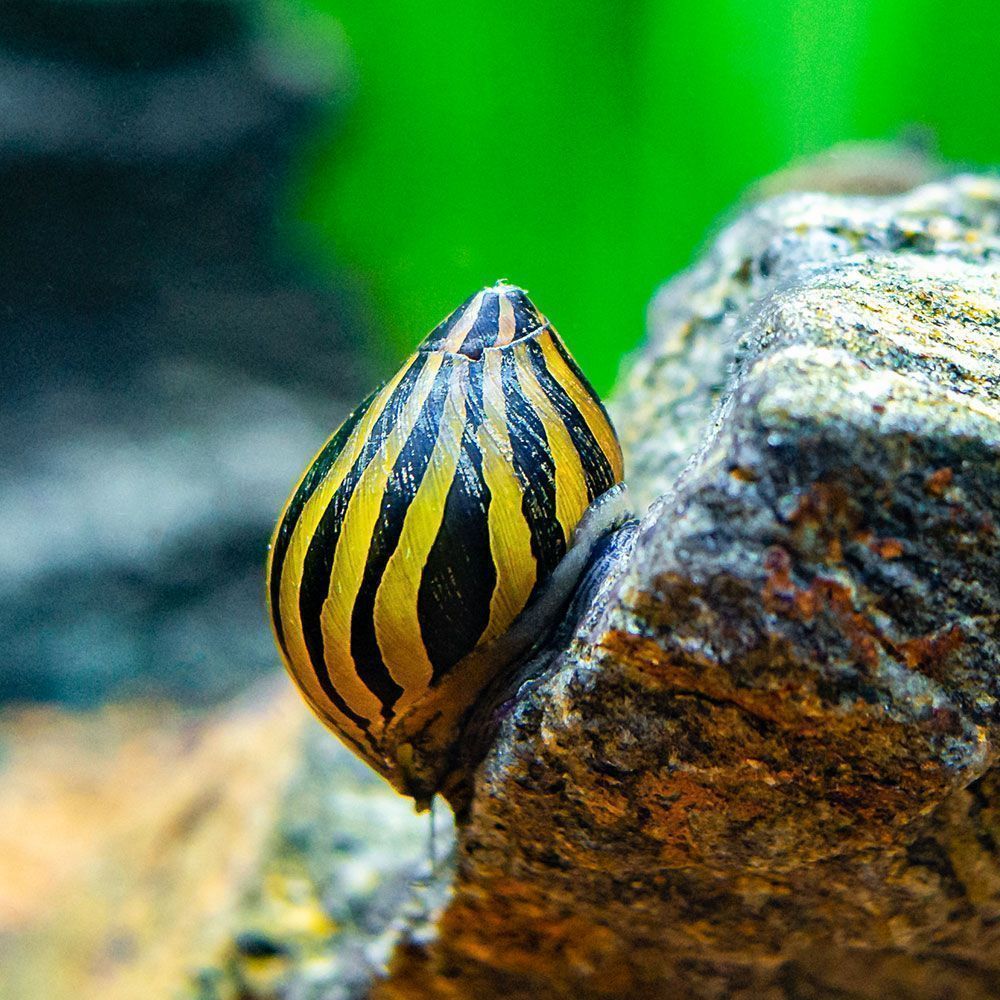
- Common Names: Zebra snail
- Average Size: Up to 2.5 cm (1 in)
- Average Lifespan: Generally 1 year, 2 years with great care
- pH Levels: 6.5-8.5
- Water Temperature: 70-80 °F (21-27 °C)
- Minimum Tank Size: 5 gallons per snail
Originating from freshwater or brackish environments of East Africa’s coastal plain, zebra nerite snails are recognized by their striking stripes.
The herbivore’s shells exhibit a zebra-like pattern with alternating dark or light brown and golden yellow or orange stripes.
3. Black Racer Nerite Snail (Neritina pulligera)
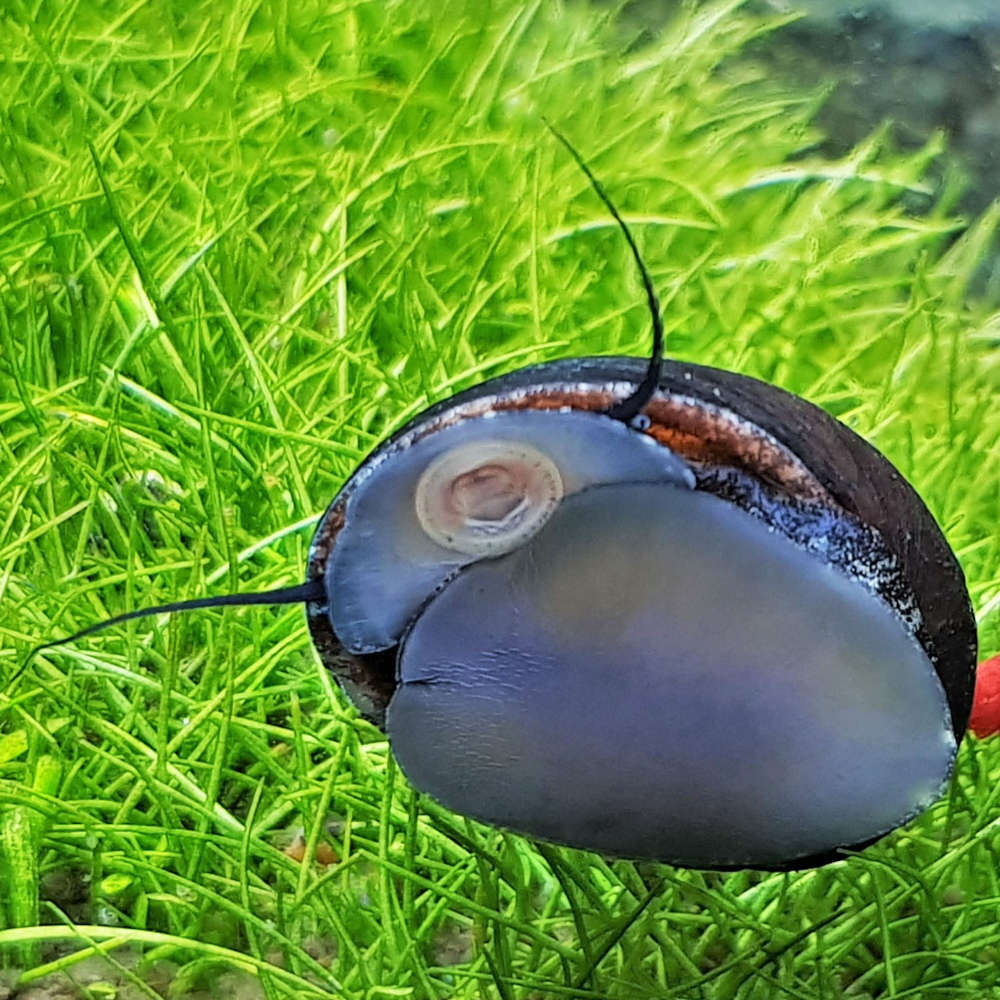
- Common Names: Military nerite snail, black military helmet snail, black nerite snail, baseball cap nerite, red-lipped nerite, dusky nerite
- Average Size: Up to 3.8 cm (1.5 in)
- Average Lifespan: Up to 2.5 years
- pH Levels: 6.5-8
- Water Temperature: 65-85 °F (18-29 °C)
- Minimum Tank Size: 5 gallons per snail
Native to Australia, South East Asia, and wide regions of the Indo-Pacific Oceans, black racer nerite snails have shiny ebony shells. Their dark bodies have white spots, and the outer lips have a deep orange inner margin.
Under proper lighting, the herbivores show hints of browns and light greens. Otherwise, it looks plain.
These freshwater snails breed in saltwater and migrate a lot.
4. Tiger Nerite Snail (Vittina turrita)
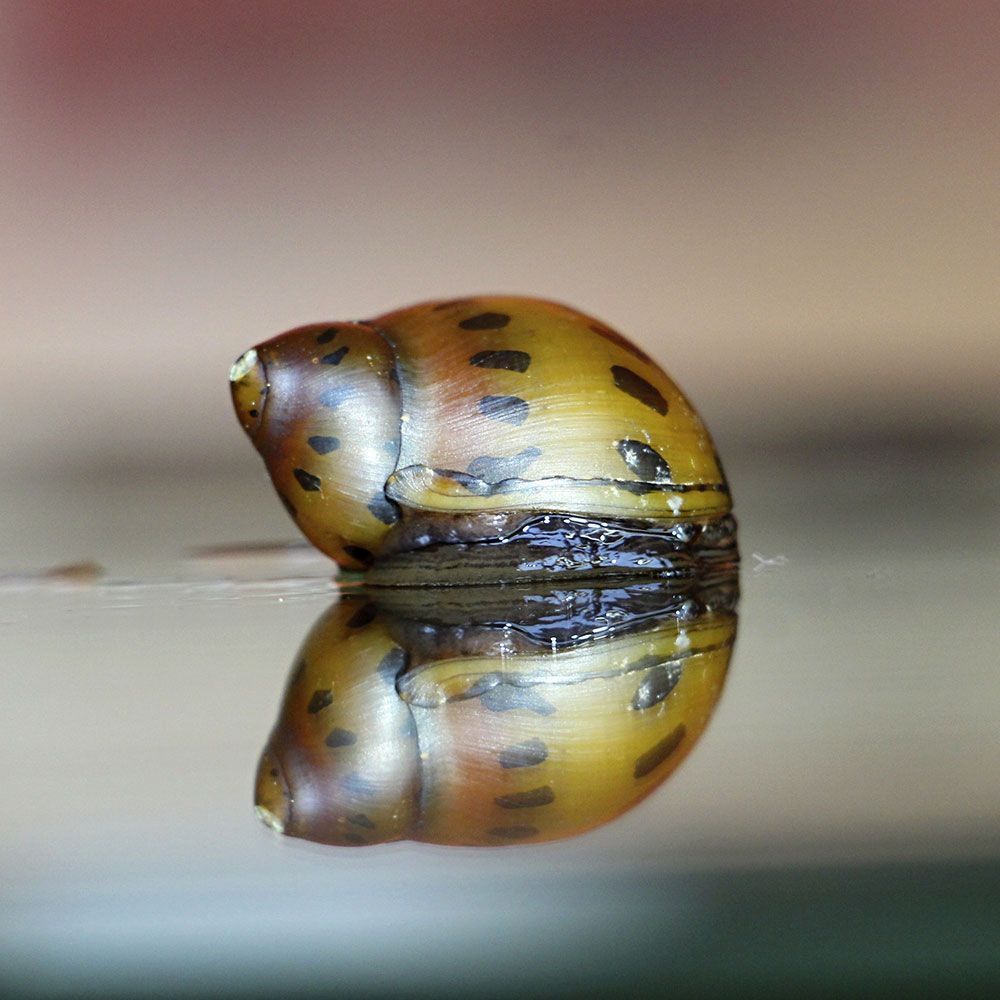
- Average Size: 2.5-3.8 cm (1-1.5 in)
- Average Lifespan: 1 year
- pH Levels: 6.5-8.5
- Water Temperature: 65-85 °F (18-29 °C)
- Minimum Tank Size: 5 Gallons
Tiger nerite snails, originating from Africa, are captivating with their tiger-like dark amber shells, which have small black markings forming encircling stripes.
The low-maintenance, beginner-friendly herbivores are adaptable to fresh or brackish water but breed in brackish water.
5. Red Racer Nerite Snail (Vittina waigiensis)
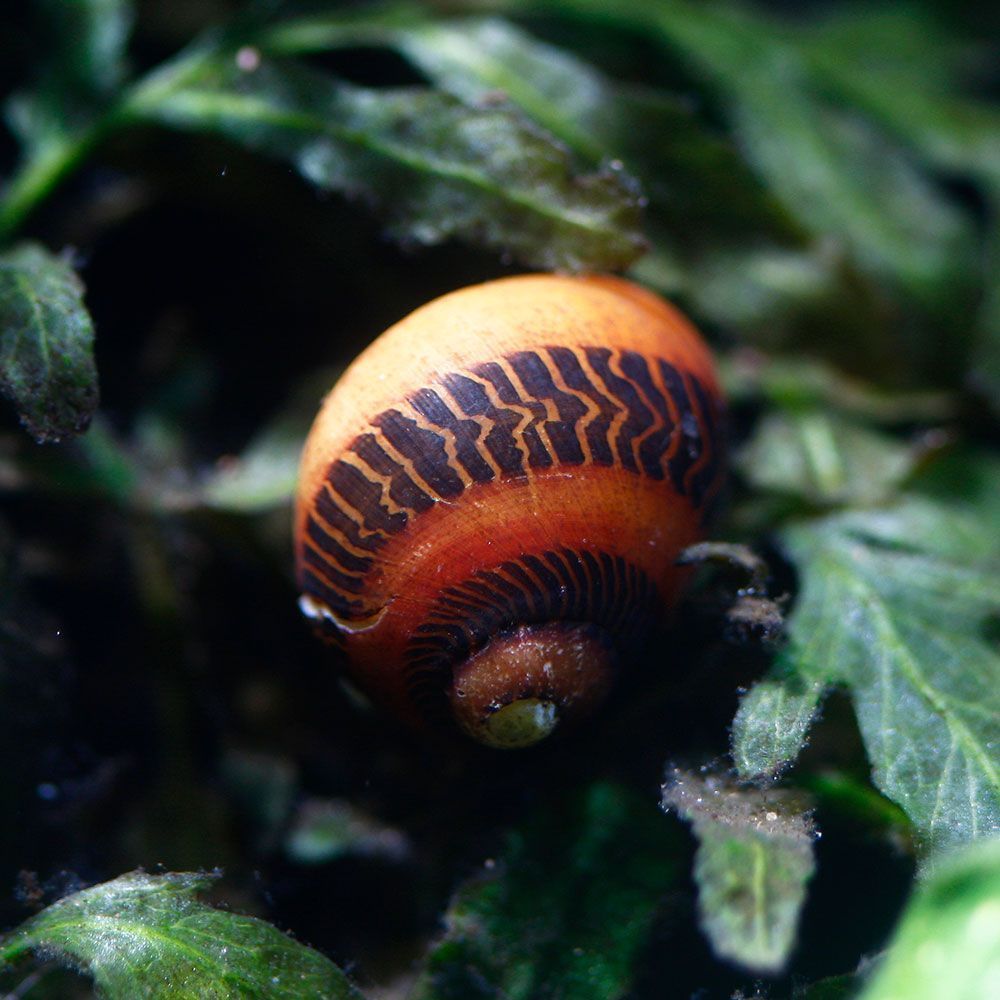
- Common Names: Gold racer nerite
- Average Size: 3 cm (1.2 in)
- Average Lifespan: Over 4 years
- pH Levels: 6.5-8
- Water Temperature: 72-88 °F (22-28 °C)
- Minimum Tank Size: 3 gallons
Originating from the Philippines and Indonesia, red racer nerites are among the most beautiful and rare snails globally.
Some have a base color of red and light orange or dark chevron stripes, resembling tire marks spiraling over their shells.
Some display predominantly red shells with small chevron stripes. Others showcase entire shells covered in chevrons.
The herbivore requires brackish or marine water to breed and are the fastest nerites.
6. Olive Nerite Snail (Vitta usnea)
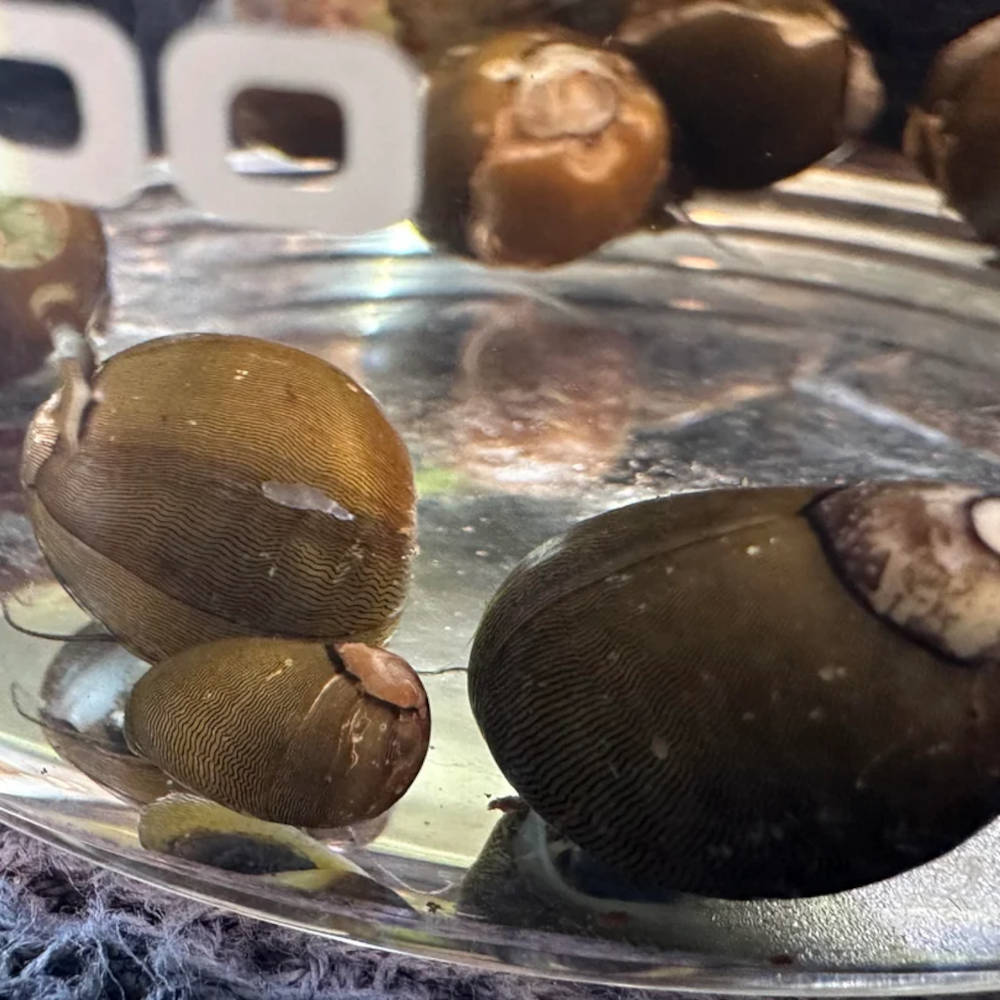
- Common Names: Tiger eye nerite snail, black marble snail
- Average Size: 1 to 1.5 inches (2.5 to 3.8 cm)
- Average Lifespan: Approximately 1 year under proper conditions
- pH Levels: 6.5 to 8.0
- Water Temperature: 65° to 85° F (18° to 29° C)
- Minimum Tank Size: 2 gallons per snail
Originating from North, Central, and South American Gulf Coast areas, these snails are aptly named as they resemble martini olives.
The euryhaline boasts rounded, smooth shells in olive to brownish-green hues and blends with plants and algae in the wild due to their color.
Up close, you can see that these herbivores’ bodies have hundreds of tiny stripes.
What is the Natural Habitat of Nerite Snails?
Nerite snails are found in the coastal plains of East Africa, which consists of the following countries:
- Kenya
- Mozambique
- Somalia
- South Africa
- Tanzania
Specifically, you’ll find the spotted nerite snails in freshwater, clinging to hard surfaces like rocks of rivers, lakes, and mangroves. They often migrate to brackish environments to reproduce. They are amphibious, i.e., they come out of water for a few hours to breathe daily.
There are lots of other nerite snail varieties that live in marine, brackish, or a mixture of environments.
how does Nerite Snails look?
Now, you must be wondering how the spotted nerite snails look; let’s describe their beauty right here.
What is the Size of Nerite Snails?
The adult spotted nerites measure around 2.5 cm (1 in) in diameter.
What is the Color of Nerite Snails?
The shell can be dark brown to black, featuring intricate yellow patterns or stripes.
What are the Features of Nerite Snails?
These have a distinctive spiral-shaped shell made of calcium carbonate, which serves as protection and support. Their round, low-profile shell is polished, smooth, and glossy.
There are tentacles on the head with eyes and an operculum – a hard plate that covers the shell opening for protection and moisture preservation. Inside the mantle cavity, there are gills to extract oxygen from water.
They have muscular feet that help them to move. The feet have a special organ called a radula– a ribbon-like structure with rows of tiny teeth that allow the snail to scrape and consume algae and organic matter from surfaces.
Is Nerite Snail male different from female?
Sexual differentiation is not possible in juveniles.
The adult males usually have slender, patterned shells, while adult females have wider shells.
Observe mating behavior for clues. Males actively pursue females and show more frequent and vigorous mating behavior. Females may lay eggs on surfaces or their shells.
What is the Behavior of Nerite Snails in a fish tank?
Nerite snails are easygoing, adaptable, peaceful, and don’t need the company of other snails. They are slow movers and mainly feed on tank algae.
They may stay still for hours or days after feeding. They can stay awake for over 30 hours, taking short naps in clusters, about seven times, during a 13-15 hour period.
These are skilled at adapting to different water conditions, including freshwater and brackish environments. They regulate their internal balance using specialized organs called nephridia, which filter waste and control essential ion levels.
They also actively move to areas with optimal conditions to avoid stress.
What is the Lifespan of Nerite Snails?
Nerite snails can usually live up to 1-2 years. With the best care, some even live up to 3 years.
Many die shortly after being introduced to a tank due to transport stress, abrupt water parameter changes, or poor water quality.
Test both the tank and transport water for pH, ammonia, nitrates, and hardness before adding snails to identify any significant differences.
Author’s Note: These snails may climb outside the tank. It’s crucial to have a secure lid to prevent them from escaping and ensure they don’t face difficulties if they accidentally fall.
If a nerite snail is upside-down, gently place it the right way up as they struggle to flip over on their own.
How to take care of Nerite Snails?
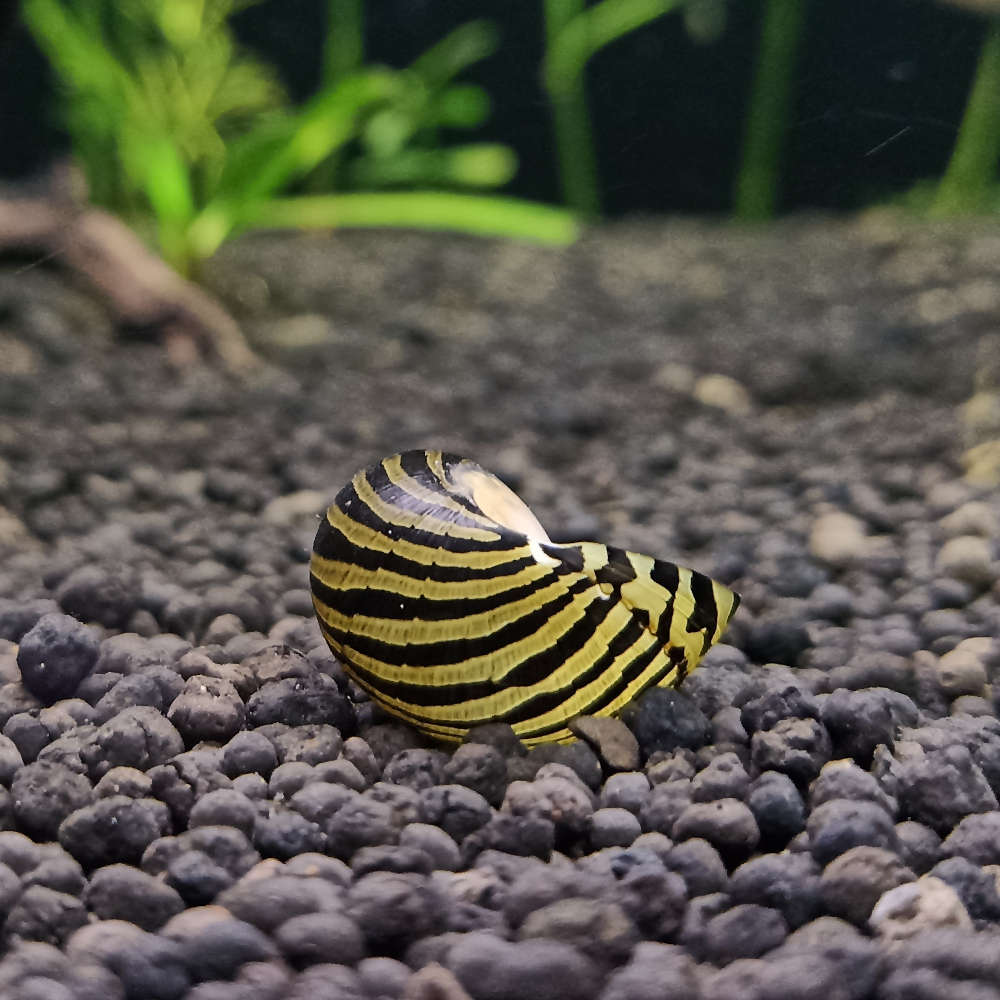
If you are interested in getting these snails already, let’s quickly learn how to care for them.
What is the Tank Size for Nerite Snails?
You can choose from 10-20 gallons. Avoid overstocking and house only one snail for every 5 gallons for ideal conditions.
What is the Water Chemistry for Nerite Snails?
Nerite snails flourish in stable, well-maintained tanks with little hard water conditions. To ensure their longevity and well-being, adhere to their water requirements.
- pH Levels: 7-8.4
- Water Temperature: 72-78 °F (22-25°C)
- Water Hardness (Freshwater): 6-12 dGH
- Ammonia: 0 ppm
- Nitrite: 0 ppm
- Nitrate: Below 30 ppm
What is the Tank Environment for Nerite Snails?
To keep your nerites healthy, you must maintain the ideal environment. Let us check out how to design the tank accordingly.
Is Substrate required for Nerite Snails?
Choose a smooth substrate like mud, dark sand, or fine gravel for easy movement and burrowing. These prevent harm to their delicate feet. Ensure there are no sharp or abrasive particles in the substrate.
Are Plants required for Nerite Snails?
Nerite snails enjoy living in planted aquariums. Live plants continuously release plant matter into the water. This provides a perfect environment, which is “not overly clean.” They won’t nibble on your live plants but might hide amongst them.
Is Lighting required for Nerite Snails?
They are sensitive to light and are nocturnal beings, so go for a low-moderate lighting intensity. Choose a light with a distinct day and night cycle for a semi-regular sleep pattern. Avoid direct sunlight, as it may dry your snails.
What type of Décor is required for Nerite Snails?
Add rocks, caves, and driftwood for algae growth, which works as a great dietary component for nerites.
Moreover, they’re nocturnal creatures and prefer quiet. These decor materials will provide shaded places to rest during the day.
What type of Filtration is required for Nerite Snails?
These, despite their small size, produce lots of waste. Some say that live plants and bacteria are enough for filtration without extra equipment.
But in my experience, it’s best to use a filter like a sponge or HOB filter to manage waste, break down nitrates and ammonia, and support good bacteria growth. These also produce minimal current in the tank.
Consider aeration for oxygenation and gas exchange.
What is the Water Flow Rate needed for Nerite Snails?
They thrive in both slow to moderate-flowing water.
Care Tip: Create a space above your tank waterline for nerites to rest. Leave a gap between the water surface and the tank rim so they can easily access the dry area.
What does Nerite Snail eat?
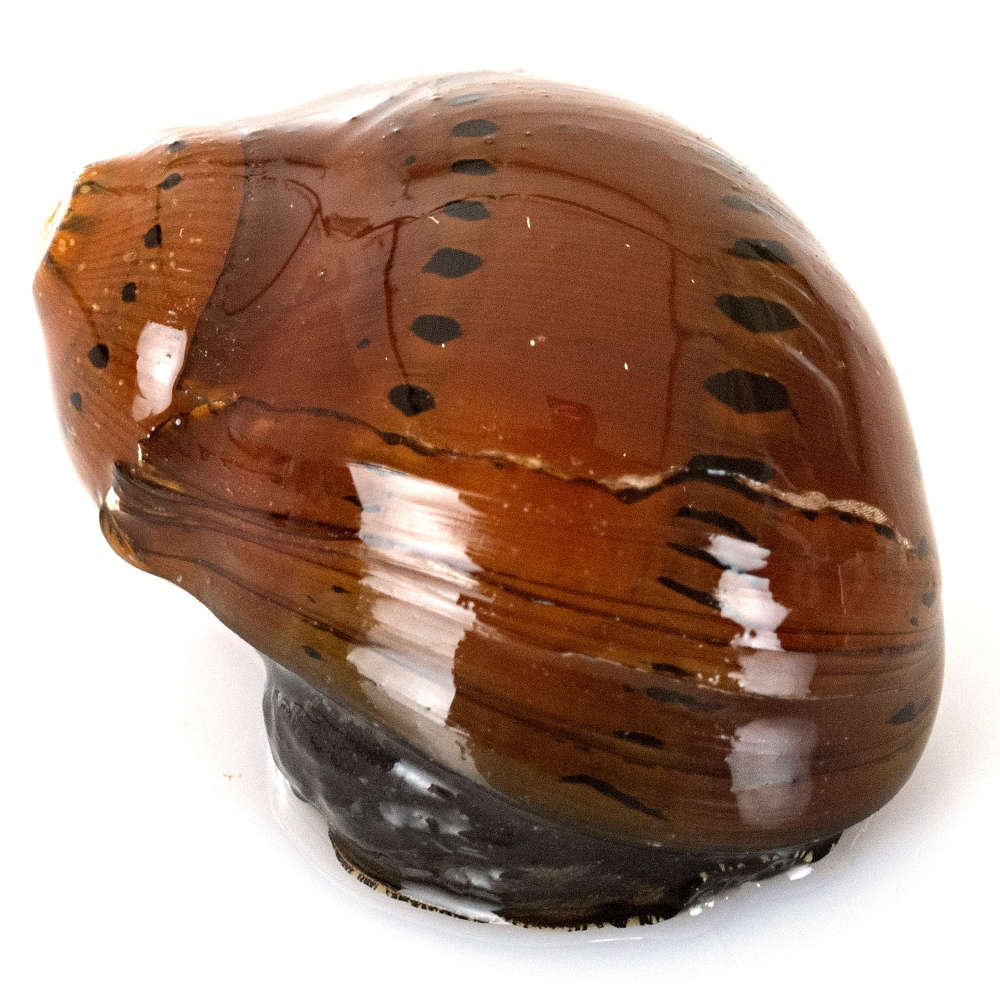
The herbivores are diligent algae eaters. They cling to surfaces, including glass, decorations, and filter intakes, as they move and feed.
They prefer
- Soft film algae
- Soft green algae
- Green spot algae
- Soft brown algae
- Brown diatoms
As scavengers, they consume leftover fish food and decaying leaves as well.
You can also offer the following:
- Algae wafers
- Blanched zucchini
- Blanched carrots
- Canned green beans
Ensure a balance in diet and prevent overfeeding or underfeeding. In soft water environments, provide them with calcium supplements, like crushed coral.
Nerite snails’ poop benefits shrimp with essential bacteria for their digestive systems.
What are the Tank Mates for Nerite Snails?
Nerite snails are peaceful and easygoing. So, you can have other friendly invertebrates and fish.
While choosing tank mates, ensure they have similar environmental needs and temperament. They coexist well with peaceful tank mates like:
- Snails: Trumpet snail, ramshorn snail, mystery snail, ivory snail, gold Inca snail
- Shrimps: Ghost shrimp, cherry shrimp, bamboo shrimp, vampire shrimp, red cherry shrimp, amano shrimp
- Barbs
- Neon tetra
- Guppy
- Cory catfish
- Otocinclus catfish
Which Tank Mates to Avoid for Nerite Snails?
Avoid keeping the following with nerites:
- Aggressive species: They may view nerites as prey and attempt to eat them.
- Snails with high appetite (assassin snails): Nerites may compete for food with them, leading to potential conflicts.
- Nipping fish (bettas): They may nip at the antennae or shell of nerites and stress them.
- Goldfish: They’re messy eaters with high waste production, which can affect nerite health. They may also nibble on the snail’s soft body parts.
- Territorial species: They may view nerites as intruders, leading to chasing, harassment, or attacks.
What are the Common Diseases in Nerite Snails?
Nerite snails are generally robust, but they are prone to certain health issues like the following:
| Disease Name | Causes | Symptoms | Treatment |
|---|---|---|---|
| Discolored Shell | Overeating vegetables | Shell discoloration | Stop feeding vegetables, let the snail only eat tank algae |
| Cracked/Damaged Shell | Weak shell | Shell crack/damage | Provide calcium supplements |
| Edema | Associated with aging | Swelling, restricted movement | No specific treatment. Maintain water parameters and provide a balanced diet to minimize discomfort |
| Missing Antenna | Biting by nippy or aggressive fish | Loss of antennas | Relocate the snails or the aggressive fish to prevent further damage |
| Copper Toxicity | Exposure to copper | Toxicity to most invertebrates. | Prevent using copper medicines |
| Stunted Shell Growth | Too low water temperature, underfeeding | Stunted shell growth | Maintain temperature above 72°F (22°C). Supplement the nerite’s diet if there’s no visible algae |
| Shell Deterioration | Young snails: Too soft and acidic water Older snails: Old age. | Cracks or holes in the shell | For young snails: Adjust water parameters (GH and pH), offer calcium-rich foods like spinach, broccoli, or cuttlebone. No treatment for older snails |
| Growth Deformities | Injured mantle – organ that creates a new shell | Irregular growth, grooves, or holes in the shell | Remove the cause of injuries, provide proper nutrition to support shell growth. |
Quick Tip: If your nerites die consecutively, ensure optimum temperature levels, calcium, nitrates, and water hardness. Promptly remove deceased snails to prevent ammonia release.
How to Breed Nerite Snails?
Nerite snails are known for their challenging breeding process due to difficult-to-feed microscopic larvae and brackish or saltwater requirements for hatching. Here’s a guide on breeding these unique snails.
Let us now look at the steps of breeding nerite snails.
1. Breeding Tank Setup
Prepare a cycled tank filled with algae, substrate, and decor. Install an airstone for proper aeration. Use marine salt to achieve brackish or saltwater conditions of salinity level: 1.005-1.010.
2. Choosing Snails
It’s challenging to differentiate these snails sexually. Observe snail behavior keenly to differentiate them.
Or, to increase the likelihood of obtaining both male and female snails, consider a group of six or more.
3. Breeding Strategies
Nerite snails don’t breed in freshwater tanks. But sometimes, small white dots may appear on various surfaces like decorations, plants, or equipment.
These are egg capsules, and each capsule holds about 70 micro eggs inside. Transfer the object to a fully saltwater breeding tank.
Or, gradually acclimate adult snails to brackish water to encourage laying eggs.
4. Mating Process
Nerite snails mate with the male positioned over the right side of the female. He inserts his organ below her mantle edge. The female then uses her foot to transfer and fix the egg capsules to the surface.
5. Larval Development & Care
You may rear the larvae in a 1-5 gallon larval tank. Keep lights on 24/7, maintain 5-10 ppt brackish water at 80-85°F (26-30°C), and limit mechanical filtration.
Protect larvae from suction with a net-covered input. Move egg capsules carefully, avoiding damage.
Depending on water temperature, eggs hatch within days to weeks. Feed the newly hatched larvae algae, golden pearls, spirulina powder, powdered fry food, and phytoplankton.
After hatching, water changes aren’t necessary if the parameters are stable. If nitrates rise, use light to gather larvae at one corner while you siphon the water.
6. Freshwater Acclimatization of Larvae
Over a span of 1-2 months, gradually acclimate larvae to freshwater by replacing small amounts of saltwater with mineral-rich freshwater.
Breeding Tip: You can’t do much to make nerite snails breed. So, provide a comfortable environment to encourage breeding.
How to Buy Nerite Snails?
To select healthy and thriving nerite snails, follow these guidelines:
- Check for intact, healthy-looking shells. Avoid specimens if shells have cracks, gashes, and nicks.
- Pick snails that are affixed to glass or hard surfaces, which indicates their active nature.
- Avoid snails lying upside down or lying at the tank bottom, sucked into their shells. These indicate potential illness or distress.
- Check that the snails are visibly inside their shells and the shell is not empty.
A word from FishInAquarium
Nerite snails stand out as exceptional additions to peaceful community aquariums. With their quirky spotted and patterned shells, they truly add to the aquarium’s aesthetics. They’re also great with planted tanks as they don’t try to nibble on them.
If you found this article informative and helpful, please consider sharing it with fellow aquarists. Feel free to reach out via email if you need any support on caring for your nerite snails.

